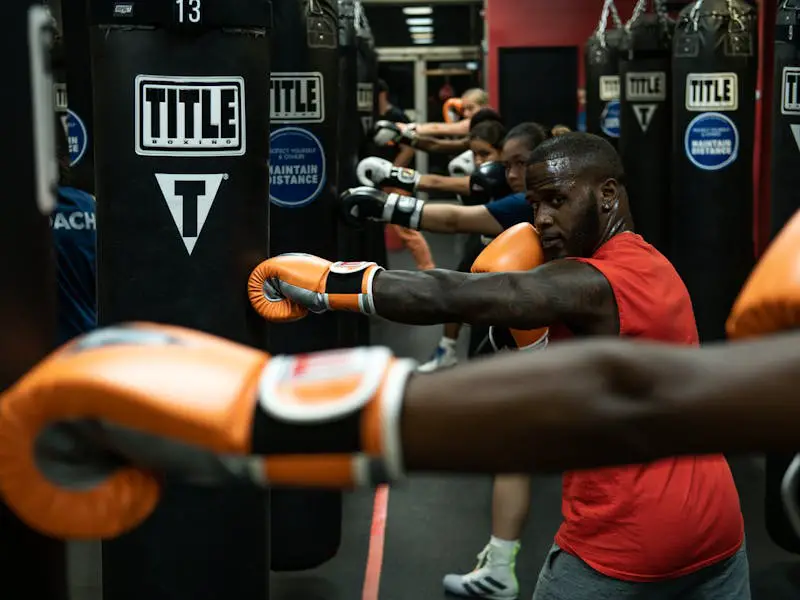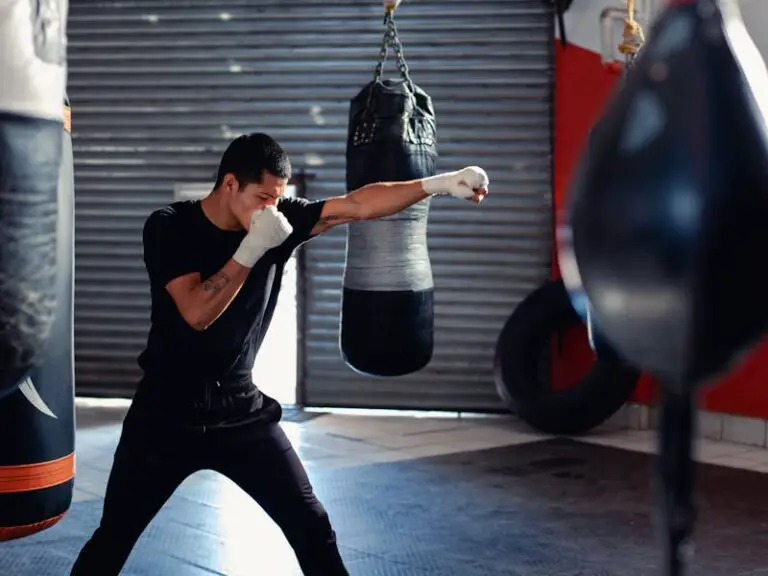Boxing is one of the most popular martial arts for people of all ages, genders, or fitness levels and many people wonder is boxing hard to learn and whether you can master it quickly.
In this article, we will discuss how easy is to pick up boxing, how long it takes to become good at it, and see if it is harder than other popular combat systems.
Is Boxing Hard to Learn?
As a concept, boxing is simple and relatively easy to learn. It focuses only on hand strikes so the majority of techniques do not require athleticism or talent to learn. The emphasis is on direct techniques and natural body movements most people are familiar with.
Of course, training becomes more complex when you enter the competition. This is where advanced skills, talent, strategies, genetics, and many other factors come into play. But as far as the amateur level is concerned, training is not too demanding.
Due to its focus on punches only, individuals of all talents and ages can develop decent skills in a reasonable time. Classes are also adaptable so that amateurs can adjust the intensity and complexity according to their limits, and still get the results.

Through repetitions and drills, you will quickly figure out how to throw basic punches like a jab, cross, uppercut, and chain multiple punches into combinations. The next task is to incorporate footwork and head movement, blocks, and more advanced workouts such as live drills.
Of course, this is only in case practitioners are committed to their goals. This includes training in a proper school, and hitting the gym at least 3 times a week.
How Long Does It Take To Learn Boxing?
An average boxing beginner needs between three and five months to master the basics. They need an additional six months of live drills and sparring to learn how to apply these skills in a real amateur match or self-defense scenario. Many experts consider this to be the “advanced” level of learning.
The exact period is based on many individual factors. This primarily includes consistency, effort, talent, and many others. Thus, some students may become amateurs after 6 months of training, while some may need up to 15 months. But overall, everyone can develop decent skills in this period.
Can you learn boxing in three months?
In the opening months, students mainly focus on basic and improving conditioning. You may expect to pick up the basics, but not to learn how to fight in matches or apply techniques in real-world situations.
Students spend most of their time working on the heavy bag, learning combos, and improving form. The coaches might ask them to hit the pads and they might start doing live drills with the partner.
On top of that, there are gruelling cardio and strength workouts. Boxing beginners do a lot of bodyweight exercises, running, and intense cardio workouts. Overall, it is a mix of aerobic and anaerobic training.
Can you learn boxing in one year?
After one year of boxing training, most students are capable of applying techniques in real situations and against resisting opponents. This means they can start competing in amateur matches and can use boxing for self-defense in real life.
Once a student picks up the basics and improves conditioning, they move to an intermediate stage. This is where they begin to spar to learn the practical application of techniques. Through intense practice, they improve timing, reactions, and instincts, and learn how to stay calm in stressful situations.
All of these skills are essential in terms of matches and self-defense and improve their fighting abilities.
Is Boxing Hard On Your Body?
Yes, boxing training can be hard on the body, notably for those who are not used to rigorous physical activity or who haven’t built up their endurance and strength gradually over time.
However, with proper training, rest, and attention to form, many people find that the benefits of boxing training outweigh the potential risks.
As with any physical activity, it’s important to listen to your body, start slowly, and gradually increase intensity to avoid overexertion and injury.
- High Intensity Workouts – boxing training often involves high-intensity interval training (HIIT), which can be very demanding on the cardiovascular system and muscles.
- Impact – training involves a lot of impact, both from hitting pads and bags and from sparring with other boxers. This can put stress on the joints, especially the wrists, elbows, shoulders, and knees.
- Muscle Soreness – the repetitive motions involved in boxing can lead to muscle soreness, particularly in the arms, shoulders, and core.
- Injury Risk – there’s a risk of injury in any contact sport, and boxing is no exception. Common injuries include sprains, strains, bruises, and even more serious injuries like fractures or concussions.
- Physical Conditioning – boxing training requires a high level of physical conditioning, including strength, endurance, speed, and agility. This can be challenging to achieve and maintain, especially for beginners.
Can You Learn Boxing At Home?
Yes, you can learn boxing basics at home and improve overall fitness and conditioning. This includes knowing how to throw punches with proper form, move around, shadow box, and go through intense workouts without tiring. Here are some quick tips:
- Watch instructional videos
- Practice your moves in front of a mirror. Shadowboxing helps you work on your technique, footwork, and combinations.
- Use heavy and speed bags as training tools
- Incorporate bodyweight exercises
But if you want to become a pro-fighter or learn how to use these skills in a real fight, you would need to train in a proper school. Training under coaches and with partners enables you to elevate your skills and put your skills to the test in sparring.
While learning boxing at home, you never know how you would react against the opponent in the ring or self-defense. There is a big difference between hitting the bag or pads and doing the same against the moving target that’s trying to hurt you. Things get even harder when you add fear and adrenalin to the mix.
Thus, you need sparring partners and coaches to teach you how to box. They help you make a smooth transition from the basics to advanced levels, and become a real boxer.
So overall, training alone at home enables you to learn how to box to a certain level. But if you are looking to compete in matches or improve your self-defense skills, then you would need proper guidance.
Is it Too Late To Start Boxing In the 20s?
No, it is not too late to start boxing in your 20s or 30s. While some pro boxers start training at a very young age, it is never too late to start boxing to improve fitness, health, and self-defense abilities.
The boxing competition scene is stacked. Thus, the younger you get into the sport, the more time you have to develop skills and experience on the amateur scene. But this doesn’t mean that you can become a pro boxer in your 20s. Moreover, many famous fighters started their journey in their 20s like:
Still, keep in mind these are the rare instances. In order to build a career, you must be talented and capable of learning quickly. This also means you would have to fast-track your career and get into pro competition sooner than most other boxers. But with firm dedication, effort, and commitment, you can make it work.
On the other side, it’s never too late to join boxing for recreation. It doesn’t matter if you are in your 30s, 40s, 50s or 60s. Boxing is simple and adaptable. When training in the amateur group, you can adjust the intensity according to your preferred level and get the most out of your abilities.
Just be sure to set realistic goals.
What Gear Do You Need To Start Boxing?
To start boxing, you’ll need some basic gear to ensure your safety and effectiveness in training. Here’s a list of essential gear for beginners:
- Boxing Gloves – Choose gloves that fit your hands comfortably and provide adequate protection for both you and your training partner. Beginners typically start with 12–16 oz gloves, depending on your weight and intended use (e.g., sparring, bag work).
- Hand Wraps – Hand wraps provide additional support and protection for your wrists, knuckles, and hands. Wrapping your hands properly can help prevent injuries such as sprains or fractures during training.
- Sports Clothing – Wear comfortable, breathable clothing that allows for a full range of motion during training. Avoid wearing clothing with zippers or buttons that could cause injury during contact drills.
- Water Bottle and Towel – Stay hydrated during your workouts by bringing a water bottle, and have a towel handy to wipe away sweat and stay comfortable during breaks.
- Gym Bag – A durable gym bag to carry your gear makes it easy to transport everything to and from your training sessions.
Beginner Mistakes To Avoid in Boxing
Do not try to skip levels. Boxing might seem simple at first glance and give you a false sense you can master it quickly. But you need to spend months drilling the same moves before you can advance to more complex ones. Here are some other boxing beginner mistakes to avoid:
- Sparring Too Soon – While sparring is crucial for development, jumping into it too soon can be overwhelming. Ensure you have a solid foundation in basic techniques and defensive skills before engaging in full-contact sparring.
- Relax – Keeping your muscles too tense can slow you down and lead to fatigue. Stay relaxed, especially in your shoulders, and learn to conserve energy.
- Ignoring Defense – Beginners might focus too much on offense and neglect defensive skills. Learn to block, slip, and parry punches effectively to minimize the chances of getting hit.
- Skipping Warm-Up – Skipping warm-up exercises can lead to injuries. Ensure you spend sufficient time warming up your muscles and joints before engaging in any boxing drills or sparring.
- Overlooking Basic Footwork: Footwork is crucial in boxing. Neglecting proper foot movement can make you an easy target and hinder your ability to generate power. Practice moving forward, backwards, and laterally, maintaining balance at all times.
Remember, improvement in boxing takes time and consistent effort. Focus on mastering the fundamentals and gradually progress as you gain experience and confidence in the sport.
How Does A Beginner Boxing Class Look Like?
A typical beginner boxing class involves both skill-specific workouts and exercises aimed to improve fitness and conditioning. Here’s a breakdown of what you might expect in an average boxing class:
Warm-up (10–15 minutes):
- Jumping rope: This helps to improve footwork, cardiovascular fitness, and coordination.
- Shadow boxing: Practice throwing punches and moving around without a partner. This warms up your muscles and helps you focus on technique.
Bag Work (20–25 minutes):
- Heavy bag work: Execute combinations and power punches on a heavy bag to build strength and improve technique.
- Speed bag or double-end bag: Enhance hand-eye coordination, timing, and speed.
Partner Drills (15–20 minutes):
- Focus mitts: Work with a partner holding mitts to practice specific combinations and improve accuracy and timing.
- Sparring (optional): Depending on your skill level and the class structure, you may engage in controlled sparring sessions with a partner.
Conditioning (10–15 minutes):
- High-intensity interval training (HIIT): Incorporate exercises like burpees, sprints, or bodyweight exercises to enhance cardiovascular fitness and overall conditioning.
- Core exercises: Strengthen your abdominal muscles to improve stability and power in your punches.
Cool Down and Stretching (10 minutes):
- Stretching exercises: Focus on flexibility and cool down your muscles to prevent injury.
- Cool-down drills: Slow-paced movements to gradually lower your heart rate.
Is Boxing Harder Than MMA?
Boxing is easier to learn than MMA because it only focuses on punches while MMA includes striking with all limbs, grappling, and ground fighting. But, boxing is harder in terms of serious injuries such as brain damage due to the far more head strikes athletes absorb in training and competition.
For instance, a beginner boxer can expect to master the basics in 6 months and develop amateur skills within a year of training. To reach the same level of skill, the same student would have to spend at least 3 or 4 years training in MMA. The explanation is simple.
MMA fighters strike with kicks, punches, knees, and elbows. They can clinch, and take each other down, and fight on the ground using holds, chokes, and joint locks. To cover all the elements, they must be skilled in multiple disciplines such as Muay Thai, BJJ, and Wrestling.
The boxing concept revolves around 5–6 different punching techniques, and mixing them with footwork and head movement. There are no kicks, takedowns, or any other techniques. The whole point is to learn how to land quick and powerful punches to the opponent’s head.
Is Boxing Dangerous For Beginners?


